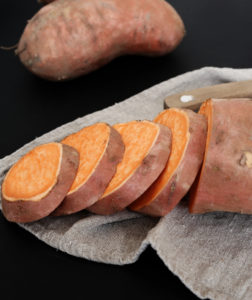Introduction to Murasaki Sweet Potatoes
Murasaki sweet potatoes, a unique variety hailing from Japan, are gaining popularity in culinary circles worldwide. Characterized by their striking purple skin and creamy white flesh, these potatoes offer a delightful combination of flavor and nutrition. Unlike their orange counterparts, Murasakis have a drier texture and a subtly sweet, nutty taste, making them a versatile ingredient in both savory and sweet dishes.
Rich in vitamins and minerals, Murasaki sweet potatoes are not just a tasty addition to meals; they are also a powerhouse of health benefits. Their low glycemic index makes them a suitable choice for those managing blood sugar levels, while their high fiber content aids in digestion. Additionally, they are packed with antioxidants, contributing to overall wellness.
In the kitchen, Murasaki sweet potatoes are celebrated for their adaptability. Whether roasted, baked, or used in soups and desserts, they maintain their distinct texture and flavor, enhancing a variety of recipes. Their growing popularity is a testament to their unique qualities, making them a sought-after ingredient for health-conscious food enthusiasts and chefs alike.
Origin and Popularity
The Murasaki sweet potato, with its origins rooted in Japan, has experienced a surge in popularity across the globe, particularly in health-conscious and culinary communities. This variety, distinct from the more common orange sweet potatoes, was developed in Japan and is named after the Japanese word for purple, reflecting its unique purple skin. Murasaki sweet potatoes are believed to have been bred from traditional sweet potatoes, which were introduced to Japan in the early 1600s, possibly from the Americas.
Their rise in popularity can be attributed to their unique flavor profile and nutritional benefits. Unlike the sweeter, orange-fleshed varieties, Murasakis offer a subtler sweetness with a slightly nutty taste, making them a versatile ingredient in a wide range of dishes. Additionally, their lower glycemic index and high antioxidant content have made them particularly appealing to health-conscious consumers.
Today, Murasaki sweet potatoes are celebrated in various cuisines around the world, not just for their health benefits but also for their culinary versatility. They have become a staple in many kitchens, appreciated for their ability to enhance both savory and sweet recipes with their unique taste and texture. Learn more about cooking and baking with Murasaki sweet potatoes.
Nutritional Profile
Health Benefits of Murasaki Sweet Potatoes
Murasaki sweet potatoes, renowned for their distinctive purple skin and white flesh, offer a plethora of health benefits, making them a valuable addition to any diet. These Japanese-origin tubers are not only a culinary delight but also a powerhouse of nutrition.
Firstly, Murasaki sweet potatoes are an excellent source of dietary fiber, which is essential for digestive health. The fiber content aids in promoting regular bowel movements and can help in managing weight by providing a feeling of fullness. Additionally, they are rich in vitamins and minerals, including Vitamin C, B6, and potassium, which are crucial for maintaining overall body functions.
One of the most significant health benefits of Murasaki sweet potatoes is their low glycemic index (GI). This means they release sugar into the bloodstream slowly, preventing spikes in blood sugar levels, making them an ideal food choice for individuals with diabetes or those monitoring their blood sugar.
Furthermore, these sweet potatoes are packed with antioxidants, particularly anthocyanins, which are found in their purple skin. Anthocyanins are known for their anti-inflammatory properties and their role in reducing the risk of chronic diseases such as heart disease and cancer.
Murasaki sweet potatoes also contribute to heart health due to their high potassium content, which helps regulate blood pressure levels. The presence of Vitamin C and B6 also supports the immune system, making these potatoes a nutritious choice for boosting overall health.
In summary, Murasaki sweet potatoes are not just a tasty addition to meals but also bring a host of health benefits, including improved digestion, blood sugar regulation, reduced risk of chronic diseases, and enhanced heart and immune health.
Comparative Nutritional Analysis with Other Sweet Potatoes
Murasaki sweet potatoes, when compared nutritionally to other sweet potato varieties, exhibit some distinct differences. While all sweet potatoes are nutritious, the specific content of vitamins, minerals, and antioxidants can vary based on the type.
Murasaki sweet potatoes are known for their lower glycemic index compared to the more common orange-fleshed varieties. This makes them a better option for blood sugar management. They are also slightly less sweet and have a firmer texture, which can be preferable in certain culinary applications.
In terms of antioxidant content, Murasaki sweet potatoes contain anthocyanins, particularly in their purple skin. These antioxidants are known for their anti-inflammatory and heart health benefits. Orange sweet potatoes, on the other hand, are rich in beta-carotene, an antioxidant that is converted to vitamin A in the body and is essential for eye health and immune function.
Both varieties are good sources of dietary fiber, vitamins C and B6, and potassium. However, the unique anthocyanin content of Murasaki sweet potatoes sets them apart, offering additional health benefits not as prevalent in other types. This makes them a valuable addition to a balanced diet, especially for those looking to increase their antioxidant intake. Discover the health benefits of Murasaki sweet potatoes.
Culinary Uses
Cooking and Baking with Murasaki Sweet Potatoes
Cooking and baking with Murasaki sweet potatoes open up a world of culinary possibilities, thanks to their unique flavor and texture. These Japanese sweet potatoes, with their firm white flesh and subtle sweetness, are incredibly versatile in the kitchen.
For baking, Murasaki sweet potatoes are an excellent choice. Their firmer texture holds up well, making them ideal for pies, bread, and muffins. When baked, they develop a rich, nutty flavor that enhances any sweet treat. They can also be used to create a healthier version of desserts, as their natural sweetness reduces the need for added sugars.
In cooking, these sweet potatoes are just as adaptable. They can be roasted to achieve a crispy exterior and creamy interior, perfect as a side dish or salad topping. Murasakis also excel in savory applications like soups, stews, and curries, where they absorb flavors beautifully while maintaining their texture.
Mashed Murasaki sweet potatoes are a delightful alternative to traditional mashed potatoes, offering a unique taste profile. They can also be sliced and fried or air-fried to make healthy chips or fries.
Grilling is another excellent way to prepare these sweet potatoes. The high heat caramelizes their sugars, bringing out their inherent sweetness and creating a deliciously charred exterior.
In summary, Murasaki sweet potatoes are a versatile ingredient that can be incorporated into a wide range of dishes, from baked goods to savory meals. Their unique flavor and texture make them a favorite among chefs and home cooks alike.
Recipe Ideas and Variations
Murasaki sweet potatoes offer a canvas for a variety of creative and delicious recipes. Here are some ideas and variations to explore:
- Murasaki Sweet Potato Fries: Slice them into thin strips, toss with olive oil, salt, and your choice of spices, and bake or air-fry until crispy. Serve with a garlic aioli or spicy ketchup.
- Stuffed Murasaki Sweet Potatoes: Bake whole potatoes until tender, then split open and stuff with a mixture of black beans, corn, diced tomatoes, and cheese for a hearty meal.
- Sweet Potato Hash: Cube and sauté with onions, bell peppers, and your favorite herbs for a flavorful breakfast hash. Top with a fried egg for added protein.
- Murasaki Mashed Potatoes: Boil and mash them with a bit of butter, cream, and a pinch of nutmeg. This can be a great side dish for grilled meats or roasted vegetables.
- Sweet Potato Pie: Use them in a pie filling for a twist on the classic dessert. Their natural sweetness and creamy texture make for a delightful pie.
- Roasted Sweet Potato Salad: Cube and roast until caramelized, then toss in a salad with mixed greens, goat cheese, and a balsamic vinaigrette.
These recipes highlight the versatility of Murasaki sweet potatoes, making them suitable for a wide range of dishes from appetizers to desserts.
Growing and Harvesting
Cultivation Tips for Murasaki Sweet Potatoes
Cultivating Murasaki sweet potatoes can be a rewarding endeavor for gardeners, given their unique flavor and nutritional benefits. Here are some essential tips for growing these distinctive tubers:
- Choosing the Right Location: Murasaki sweet potatoes thrive in warm, sunny environments. Select a planting site that receives full sunlight for most of the day. They grow best in temperatures between 65°F and 85°F.
- Soil Preparation: These sweet potatoes prefer well-drained, sandy loam soil with a slightly acidic to neutral pH. Before planting, enrich the soil with compost or well-rotted manure to ensure it is nutrient-rich and well-aerated.
- Planting: Plant Murasaki sweet potato slips (sprouts from mature sweet potatoes) after the last frost when the soil has warmed. Space the slips about 12-18 inches apart in rows that are 3-4 feet apart to allow ample room for growth.
- Watering: Regular watering is crucial, especially during the early growth stage and hot weather. However, avoid overwatering, as this can lead to root rot.
- Weed Control: Keep the area around the plants weed-free. Mulching can help suppress weeds, retain soil moisture, and regulate soil temperature.
- Harvesting: Murasaki sweet potatoes are typically ready for harvest in about 90-120 days after planting. The leaves will start to yellow as they mature. Carefully dig around the plant to avoid damaging the tubers.
- Curing and Storage: After harvesting, cure the sweet potatoes in a warm, humid place for about 10 days to enhance their sweetness and extend shelf life. Store in a cool, dry place.
By following these cultivation tips, gardeners can successfully grow Murasaki sweet potatoes and enjoy their unique taste and health benefits right from their backyard.
Harvesting and Storage Practices
Harvesting and storing Murasaki sweet potatoes correctly is crucial for maintaining their quality and extending their shelf life. Here are some guidelines:
- Harvesting Time: Murasaki sweet potatoes are typically ready for harvest 90 to 120 days after planting. The right time to harvest is when the leaves and vines begin yellowing. Gently dig around the plant, being careful not to bruise the potatoes.
- Curing Process: After harvesting, cure the sweet potatoes to improve their flavor and storage life. Place them in a warm (about 85°F), humid (80-90% humidity) environment for 10 to 14 days. This process heals any skin damages and enhances sweetness.
- Storage Conditions: Once cured, store the sweet potatoes in a cool (about 55°F), dark, and well-ventilated place. Avoid refrigeration as cold temperatures can alter their taste and texture.
- Handling: Handle them gently to prevent bruising.
- Check Regularly: During storage, check periodically for any signs of spoilage or rot and remove affected potatoes to prevent it from spreading.
By adhering to these harvesting and storage practices, you can enjoy your Murasaki sweet potatoes for several months, ensuring a steady supply of this nutritious and flavorful vegetable. For more on this, check out cultivation tips for Murasaki sweet potatoes.
Frequently Asked Questions
Q: What distinguishes Murasaki sweet potatoes from other types?
A: These sweet potatoes stand out with their purple skin and white flesh. They are firmer and have a subtly sweet, nutty taste, unlike the softer, sweeter orange varieties. Additionally, their lower glycemic index makes them a great option for those managing blood sugar.
Q: What’s the best way to store these sweet potatoes?
A: Post-harvest, it’s ideal to store them in a cool, dark, and well-ventilated area, preferably at about 55°F. It’s important to avoid refrigeration, as it can impact their flavor and texture.
Q: Are these sweet potatoes healthier than other types?
A: They share similar nutritional profiles with other varieties, being high in fiber, vitamins, and antioxidants. The lower glycemic index is a plus for blood sugar management.
Q: What cooking methods work best for these potatoes?
A: They are versatile – baking, roasting, steaming, or frying all work well. Baking or roasting especially enhances their natural sweetness and nutty taste.
Q: How long do they last after being harvested?
A: With proper curing and storage, they can be kept for several months. It’s important to regularly inspect for any spoilage and use the damaged ones early.
Buying Guide
Where to Find Murasaki Sweet Potatoes:
You can find these unique sweet potatoes at specialty Asian markets, health food stores, and larger supermarkets with diverse produce sections. Their increasing popularity has also made them a common sight at local farmers’ markets.
Selecting the Best Quality:
When picking out these potatoes, opt for ones that are firm to the touch and free from any soft spots, bruises, or signs of decay. Ideal tubers have smooth, uniformly purple skin and are devoid of major blemishes or cuts. Steer clear of any that have begun to sprout, as this is often a sign of aging.
Size and Shape:
For even cooking, choose potatoes that are consistent in size and shape. Typically, the smaller to medium-sized ones tend to be more flavorful and tender.
Storing After Purchase:
Post-purchase, it’s best to store them in a cool, dry place, away from direct sunlight. Refrigeration is not recommended for these sweet potatoes, as it can alter their flavor and texture.




